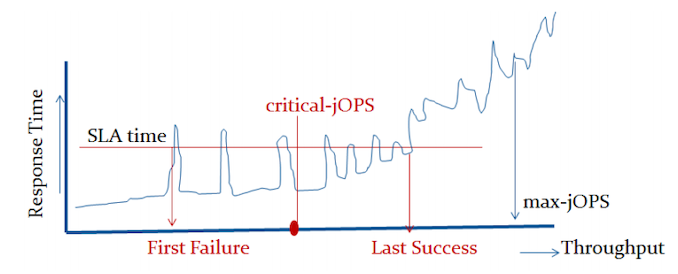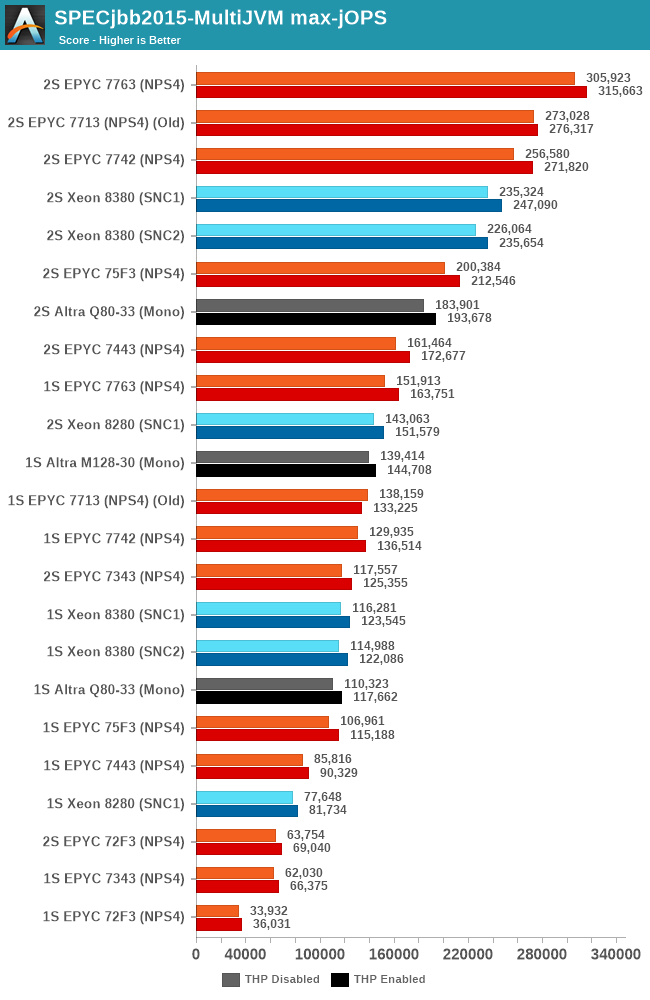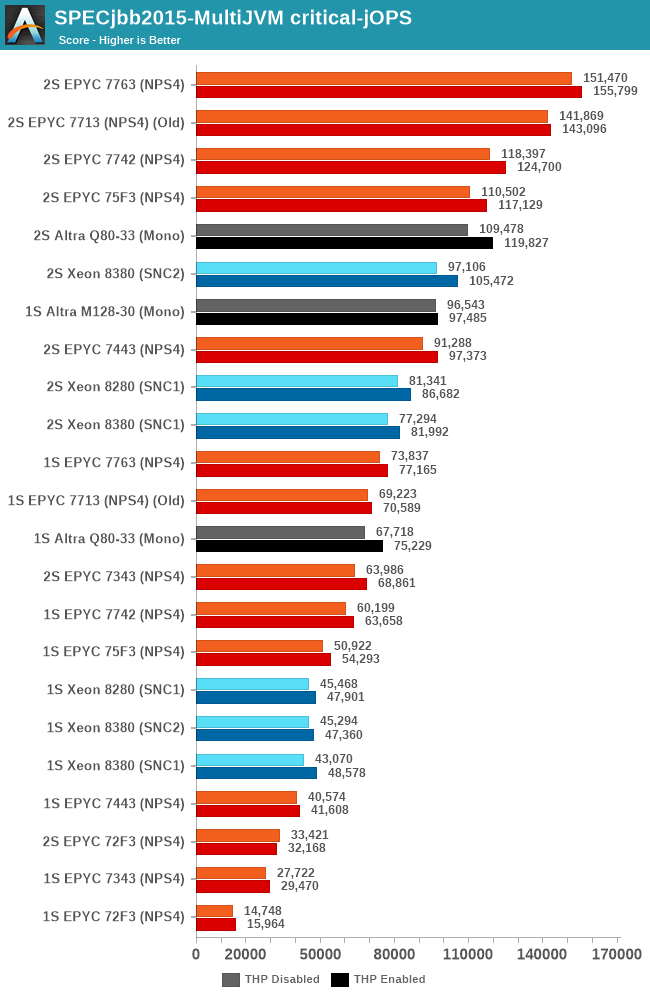The Ampere Altra Max Review: Pushing it to 128 Cores per Socket
by Andrei Frumusanu on October 7, 2021 8:00 AM EST- Posted in
- Servers
- Arm
- Neoverse N1
- Ampere
- Altra Max
SPECjbb MultiJVM - Java Performance
Moving on from SPECCPU, we shift over to SPECjbb2015. SPECjbb is a from ground-up developed benchmark that aims to cover both Java performance and server-like workloads, from the SPEC website:
“The SPECjbb2015 benchmark is based on the usage model of a worldwide supermarket company with an IT infrastructure that handles a mix of point-of-sale requests, online purchases, and data-mining operations. It exercises Java 7 and higher features, using the latest data formats (XML), communication using compression, and secure messaging.
Performance metrics are provided for both pure throughput and critical throughput under service-level agreements (SLAs), with response times ranging from 10 to 100 milliseconds.”
The important thing to note here is that the workload is of a transactional nature that mostly works on the data-plane, between different Java virtual machines, and thus threads.
We’re using the MultiJVM test method where as all the benchmark components, meaning controller, server and client virtual machines are running on the same physical machine.
The JVM runtime we’re using is OpenJDK 15 on both x86 and Arm platforms, although not exactly the same sub-version, but closest we could get:
EPYC & Xeon systems:
openjdk 15 2020-09-15
OpenJDK Runtime Environment (build 15+36-Ubuntu-1)
OpenJDK 64-Bit Server VM (build 15+36-Ubuntu-1, mixed mode, sharing)
Altra system:
openjdk 15.0.1 2020-10-20
OpenJDK Runtime Environment 20.9 (build 15.0.1+9)
OpenJDK 64-Bit Server VM 20.9 (build 15.0.1+9, mixed mode, sharing)
Furthermore, we’re configuring SPECjbb’s runtime settings with the following configurables:
SPEC_OPTS_C="-Dspecjbb.group.count=$GROUP_COUNT -Dspecjbb.txi.pergroup.count=$TI_JVM_COUNT -Dspecjbb.forkjoin.workers=N -Dspecjbb.forkjoin.workers.Tier1=N -Dspecjbb.forkjoin.workers.Tier2=1 -Dspecjbb.forkjoin.workers.Tier3=16"
Where N=160 for 2S Altra test runs, N=128 for 1S Altra Max runs, N=80 for 1S Altra test runs, N=112 for 2S Xeon 8280, N=56 for 1S Xeon 8280, and N=128 for 2S and 1S on the EPYC system. The 75F3 system had the worker count reduced to 64 and 32 for 2S/1S runs, with the 7443, 7343 and 72F3 also having the same thread to core ratiio. The Xeon 8380 was running at N=140 for 2S Xeon 8380 and N=70 for 1S - the benchmark had been erroring out at higher thread counts.
In terms of JVM options, we’re limiting ourselves to bare-bone options to keep things simple and straightforward:
EPYC systems:
JAVA_OPTS_C="-server -Xms2g -Xmx2g -Xmn1536m -XX:+UseParallelGC "
JAVA_OPTS_TI="-server -Xms2g -Xmx2g -Xmn1536m -XX:+UseParallelGC"
JAVA_OPTS_BE="-server -Xms48g -Xmx48g -Xmn42g -XX:+UseParallelGC -XX:+AlwaysPreTouch"
Xeon Cascade Lake systems:
JAVA_OPTS_C="-server -Xms2g -Xmx2g -Xmn1536m -XX:+UseParallelGC"
JAVA_OPTS_TI="-server -Xms2g -Xmx2g -Xmn1536m -XX:+UseParallelGC"
JAVA_OPTS_BE="-server -Xms172g -Xmx172g -Xmn156g -XX:+UseParallelGC -XX:+AlwaysPreTouch"
Xeon Ice Lake (SNC1) & Altra systems:
JAVA_OPTS_C="-server -Xms2g -Xmx2g -Xmn1536m -XX:+UseParallelGC"
JAVA_OPTS_TI="-server -Xms2g -Xmx2g -Xmn1536m -XX:+UseParallelGC"
JAVA_OPTS_BE="-server -Xms192g -Xmx192g -Xmn168g -XX:+UseParallelGC -XX:+AlwaysPreTouch"
Xeon Ice Lake systems (SNC2):
JAVA_OPTS_C="-server -Xms2g -Xmx2g -Xmn1536m -XX:+UseParallelGC"
JAVA_OPTS_TI="-server -Xms2g -Xmx2g -Xmn1536m -XX:+UseParallelGC"
JAVA_OPTS_BE="-server -Xms96g -Xmx96g -Xmn84g -XX:+UseParallelGC -XX:+AlwaysPreTouch"
The reason the Xeon CLX system is running a larger back-end heap is because we’re running a single NUMA node per socket, while for the Altra and EPYC we’re running four NUMA nodes per socket for maximised throughput, meaning for the 2S figures we have 8 backends running for the Altra and EPYC and 2 for the Xeon, and naturally half of those numbers for the 1S benchmarks.
For the Ice Lake system, I ran both SNC1 (one NUMA node) as SNC2 (two nodes), with the corresponding scaling in the back-end memory allocation.
The back-ends and transaction injectors are affinitised to their local NUMA node with numactl –cpunodebind and –membind, while the controller is called with –interleave=all.
The max-jOPS and critical-jOPS result figures are defined as follows:
"The max-jOPS is the last successful injection rate before the first failing injection rate where the reattempt also fails. For example, if during the RT-curve phase the injection rate of 80000 passes, but the next injection rate of 90000 fails on two successive attempts, then the max-jOPS would be 80000."
"The overall critical-jOPS is computed by taking the geomean of the individual critical-jOPS computed at these five SLA points, namely:
• Critical-jOPSoverall = Geo-mean of (critical-jOPS@ 10ms, 25ms, 50ms, 75ms and 100ms response time SLAs)
During the RT curve building phase the Transaction Injector measures the 99th percentile response times at each step level for all the requests (see section 9) that are considered in the metrics computations. It then computes the Critical-jOPS for each of the above five SLA points using the following formula:
(first * nOver + last * nUnder) / (nOver + nUnder) "

That’s a lot of technicalities to explain an admittedly complex benchmark, but the gist of it is that max-jOPS represents the maximum transaction throughput of a system until further requests fail, and critical-jOPS is an aggregate geomean transaction throughput within several levels of guaranteed response times, essentially different levels of quality of service.
On the SLA graph with the response times across increasing load, we see the Altra Max not differ too much from its predecessor, though it’s simply showcasing improved performance.

In our initial review of the Q80-33 last year, we had noted that the chip offered lacklustre performance metrics in the SPECjbb benchmark, and though this was somehow attributed to Java performance on AArch64. After spending some more time trying to debug the issue prior to this review, I surprisingly found out that the issue, at least in our configuration, was due to the Altra chip’s operating mode. While we first had tested the chip in quadrant mode, where the chip is partitioned in respective four NUMA nodes, and running four SPECjbb back-ends (one per NUMA node). Running the chip in monolithic mode as an experiment, surprisingly resolved all our performance issues with SPECjbb, with the Q80-33 now running in line where Arm had expected the system to land, which meant increase in the max-jOPS metric and a more massive increase in the critical-jOPS metric as we’ll see in a bit. Unfortunately, trading in one issue with another, we ran into other issues on the 2-socket test scenario where the test ran into issues at large thread counts. The 2S Q80-33 figures here only stresses 130 cores, while I wasn’t able at all to get 2S M128-30 figures at reasonable core counts, so I completely omitted results here.
Focusing on the 1-socket results instead, both the Q80-33 and the new M128-30 now showcase much better performance than what we had seen in the first review of the Altra. The new M128-30 sees a +26% boost in peak throughput performance compared to the Q80-33, however, the chip still lags behind AMD’s flagship EPYC 7763.
The Altra Max here not only is able to increase performance through more cores, but it’s also just outright able to make more usage of its system TDP of 250W. The workload being more data-plane bound, which is also the reason it scales well with SMT, had the effect that the 80-cores on the Q80-33 were running at lower execution resources and lower power, averaging at ~180W, quite below the 250W TDP. The per-core utilisation doesn’t change on the M128-30, but throwing more cores at the matter does help saturate more of the available TDP and result in more performance.

The new critical-jOPS figures for this review are massively improved, with the Q80-33 now posting double that of what we had originally measured. The new M128-30 now further pushes this up, reaching an impressive figure of 96k-jOPS, significantly above the second-best CPU which is the EPYC 7763 at 73k. These new results are much more in line with what we had expected of a single large monolithic CPU design, and showcases the Altra Max in its best possible light and what Ampere tries to focus on – better performance predictability than what the competition can offer with SMT.
We’ll continue to try to figure out what’s happening with the system in the dual-socket scenarios – it’s possible we’re hitting some sort of inherent scaling issue with SPECjbb at these massive thread counts.











60 Comments
View All Comments
mode_13h - Thursday, October 7, 2021 - link
> x86 still commands 99% of the server market.Depends on what you consider the "server market", but AWS is very rapidly switching over. Others will follow.
Lots of cloud compute just depends on density and power-efficiency. And here's where ARM has a real advantage.
Wilco1 - Thursday, October 7, 2021 - link
According to https://www.itjungle.com/2021/09/13/the-cacophony-... Arm server revenue has been 4-5% over the last few quarters.schujj07 - Friday, October 8, 2021 - link
Anything under 10% market share in the server world is basically considered a niche player. Right now AMD is over 10% so they are finally seen as an actual player in the market.Spunjji - Friday, October 8, 2021 - link
Pointing at current market share that resulted from a lack of viable ARM competition isn't a great argument for your prediction that ARM will not gain market share, especially when you're being presented with evidence of viable ARM competition.mode_13h - Thursday, October 7, 2021 - link
> Before AMD can disrupt Intel in the server,*before* ? This is already happening! You can clearly see it in AMD's server marketshare, as well as the price structure of Ice Lake.
> And now Intel is coming back with Saphire Rapids. Doesn't look good for AMD.
AMD has Genoa, V-Cache, and who knows what else in the pipeline. Oh, and they can also build an ARM core just as good as anyone (with the possible exceptions of Apple and Nuvia/Qualcomm).
yetanotherhuman - Friday, October 8, 2021 - link
Not even in slight agreement. Different architecture.eastcoast_pete - Thursday, October 7, 2021 - link
Thanks Andrei, great analysis! IMO, the biggest problem Ampere and other firms that develop server CPUs based on ARM designs is that their natural customers - large, cloud-type providers - pretty much all have their own, in-house designed ARM-based CPUs, and won't buy thousands of third party CPUs unless they do something their own can't do, or nowhere near as well. AWS, Google, MS, and Apple still buy x86 CPUs from Intel or AMD because there is a customer demand for those instances, but also try to shift as much as they can to their own, home-grown ARM server systems. In this regard, has anyone heard any updates about the ARM designs supposedly in development at MS? Maybe Ampere can get themselves bought out by them?name99 - Friday, October 8, 2021 - link
“own house-designed ARM-based CPU’s”?We obviously have Graviton. Apple seem a reasonable bet at some point. Maybe a large Chinese player.
Do we have any evidence (as opposed to hypotheses and rumors) of Google, Facebook, Microsoft, or most of China? Or other smaller but still large players like Yandex or Cloudflare?
Sivar - Thursday, October 7, 2021 - link
This is a proper old-school deep CPU review.vegemeister - Thursday, October 7, 2021 - link
Text says Intel Xeon 8380 is running at 205 W power limit, but the table says 270 W. Which is it? I assume 270 W like ARK says?